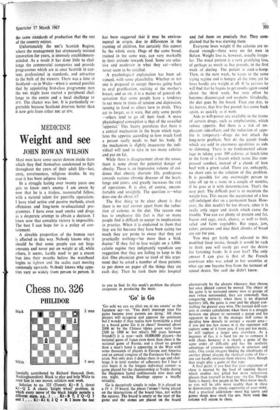Chess no. 326
PHILIDOR
Specially contributed by Richard Hancock (Iver, Buckinghamshire). Black to play and help White to mate him in two moves; solution next week.
Solution to no. 325 (Tuxen): Kt – B 3, threat Kt – Q 2. A classic 'knight wheel' problem, in which every move of the black knight permits a different mate, e.g., I Kt – B 7; 2 Q - Q 3
and 1 . Kt –Kt 6; 2 Q x B. I leave the rest
to you tofind. In this week's problem the players cooperate in producing the mate.
`Go' is Go
'Go uchiwa oya no shini me ni mo awanu' as the Japanese say—or, 'You don't interrupt your Go game because your parents are dying.' All chess players will recognise and approve the sentiment but I wonder if they realise how formidable a rival as a board game Go is to chess? Invented about 2000 sc by the Chinese (dates given vary from 2300 to 1800 ac but what's 500 years between friends?) it is now—with 10,000,000 players—the national game of Japan even more than chess is the national game of Russia; and a cloud no greater than a man's hand is appearing in the West with some thousands of players in Europe and America and an annual congress of the European Go Feder- ation. Not only does it defeat chess in age and chal- lenge it in total number of adherents but I fear it also beats it in the longest individual contest—a game played for the championship at Yeddo during the Shogunate lasted continuously nine days and one night, making Hastings appear a mayfly triviality.
Go is deceptively simple in rules. It is played on a 19 x 19 board, the pieces ('stones') being placed on the intersections of the board lines, not within the squares. The board is empty at the start of the game and the stones are placed on the board alternatively by the players wherever they choose but once played cannot be moved. The object of the game is to surround enemy men or groups of men (when surrounded, they are removed), thus conquering territory; when there is no disputed territory left, the game is over and the player con- trolling the greater area wins. The tactical skill con- sists in correct calculations when there is a struggle between one player to surround dgroup and his opponent to save it; the strategic skill comes in deciding how densely to occupy a vacant area— if you put too few stones in it. the opponent will capture some of it from you. if you put too many, he will capture a larger area elsewhere. As a beginner at Go, it is hard for me to compare it with chess; however it is clearly a game of the same order of difficulty and has the aesthetic advantage of extreme simplicity in structure and rules. One could imagine finding the inhabitants of another planet playing the identical game of Go- one can hardly envisage them playing chess. though they might play a game of that type. A final point; if you find that your enjoyment of chess is marred by the load of opening theory which enables less gifted but more industrious --- players than yourself to beat you-try Go. Though there is theory, few people in the West know much; so you will be able more readily than in chess to demonstrate the innate superiority of your mind. And a practical addendum—most big sports and games shops now stock Go sets. Next week this column will return to chess.






























 Previous page
Previous page